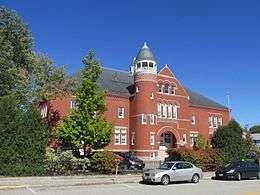Dingley Building
The Dingley Building, formerly the Oak Street School, is a historic municipal building at 36 Oak Street in Lewiston, Maine. Built in 1890, it is a distinctive local example of Richardsonian Romanesque architecture, designed by local architect George M. Coombs. It was added to the National Register of Historic Places in 1976.[1] It now houses the Lewiston school system's administrative offices.
Oak Street School | |
 Oak Street School | |
  | |
| Location | 36 Oak Street, Lewiston, Maine |
|---|---|
| Coordinates | 44°5′55″N 70°12′58″W |
| Built | 1890 |
| Architect | George M. Coombs |
| Architectural style | Romanesque Revival |
| NRHP reference No. | 76000190[1] |
| Added to NRHP | October 8, 1976 |
Description and history
The Dingley Building stands near the eastern edge of Lewiston's commercial downtown area, on a lot bounded by Middle, Oak, and Bates Streets. It is a two-story masonry structure, built of red brick with stone trim. It is covered by a tall hip roof, and is set on a raised basement, from which it is separated by a stone beltcourse. The main entrance is recessed in a large round-arch opening, which shelters the stairs providing access. The entrance is set in a projecting gabled section, from which a turret rises at the left corner, topped by an open belvedere and a convex circular roof. Windows in the projecting section above the entrance are set in round-arch openings, in a group of four on the second level, and in a Palladian-style group of three in the gable.[2]
The school building was designed by architect George M. Coombs and was built in 1890.[3] The name was changed to the Dingley Building in 1899 in honor of Nelson Dingley, Jr., a former governor of Maine and longtime congressman from Maine's second district.[3] It was later used as an elementary school, then the headquarters for the Lewiston Board of Education.[3] It remains the central office for the school district today.[4] The Lewiston Historical Commission also meets in the building.[5]
A lightning bolt struck the Dingley Building in June 2008, causing no injuries, but resulting in moderate damage to the wooden tower as well as utilities.[6]
References
- "National Register Information System". National Register of Historic Places. National Park Service. January 23, 2007.
- "NRHP nomination for Oak Hill School". National Park Service. Retrieved 2016-05-28.
- Dingley Building, Oak Street School, Lewiston, Maine Memory Network.
- "Lewiston Public Schools administration". Archived from the original on 2013-11-12. Retrieved 2013-11-12.
- Lewiston Historical Commission
- Max Mogensen, Lightning strikes Dingley building, Lewiston-Auburn Sun Journal, July 1, 2008.